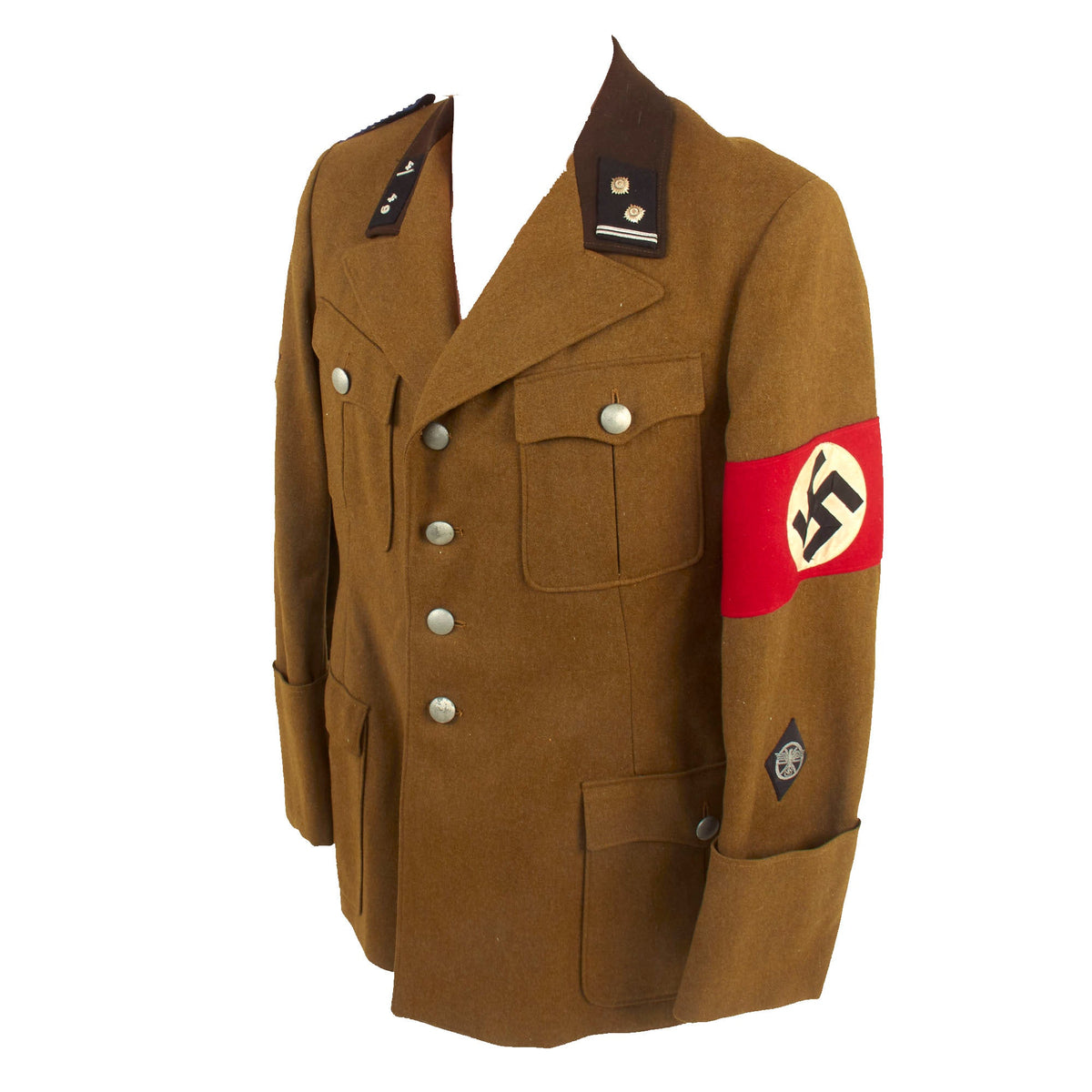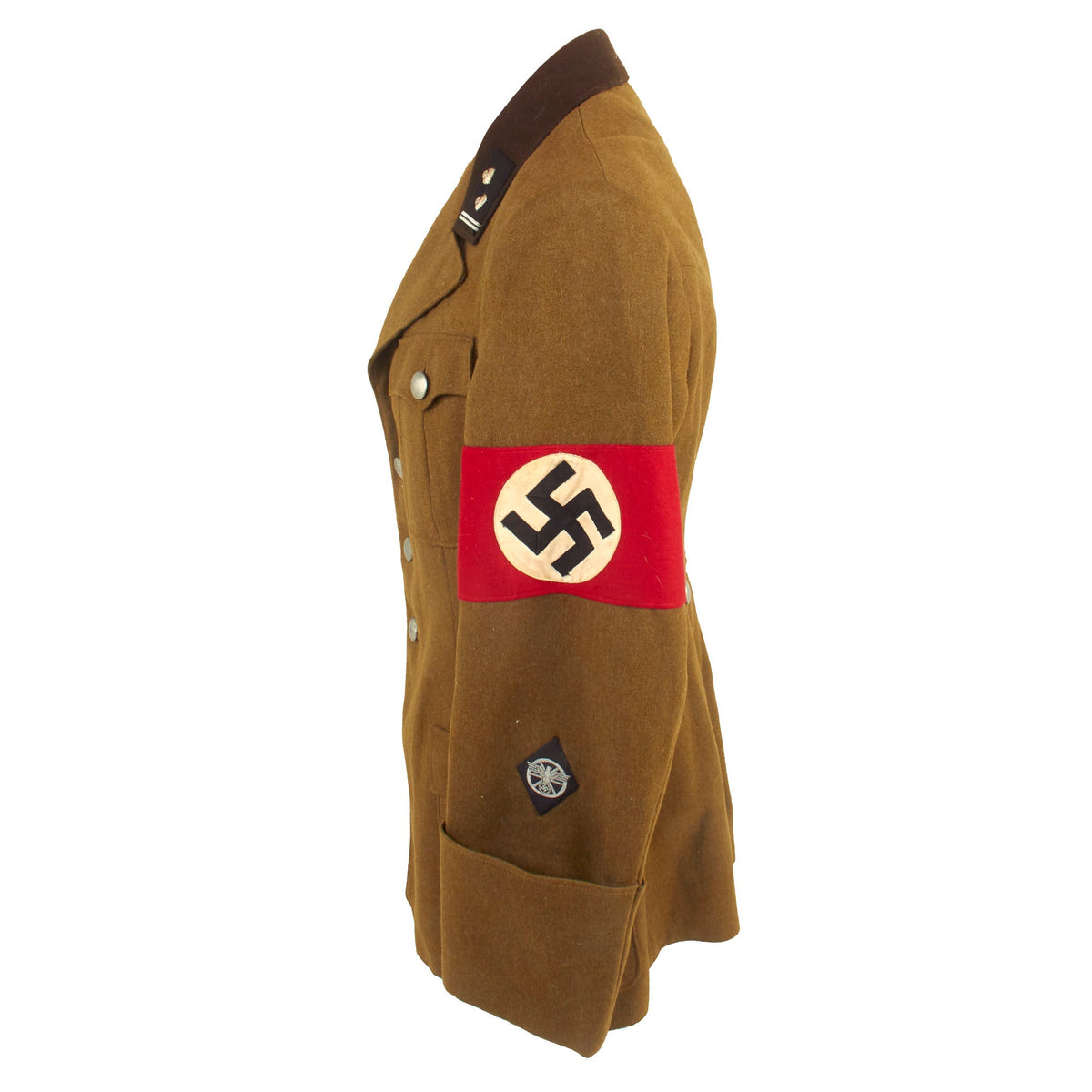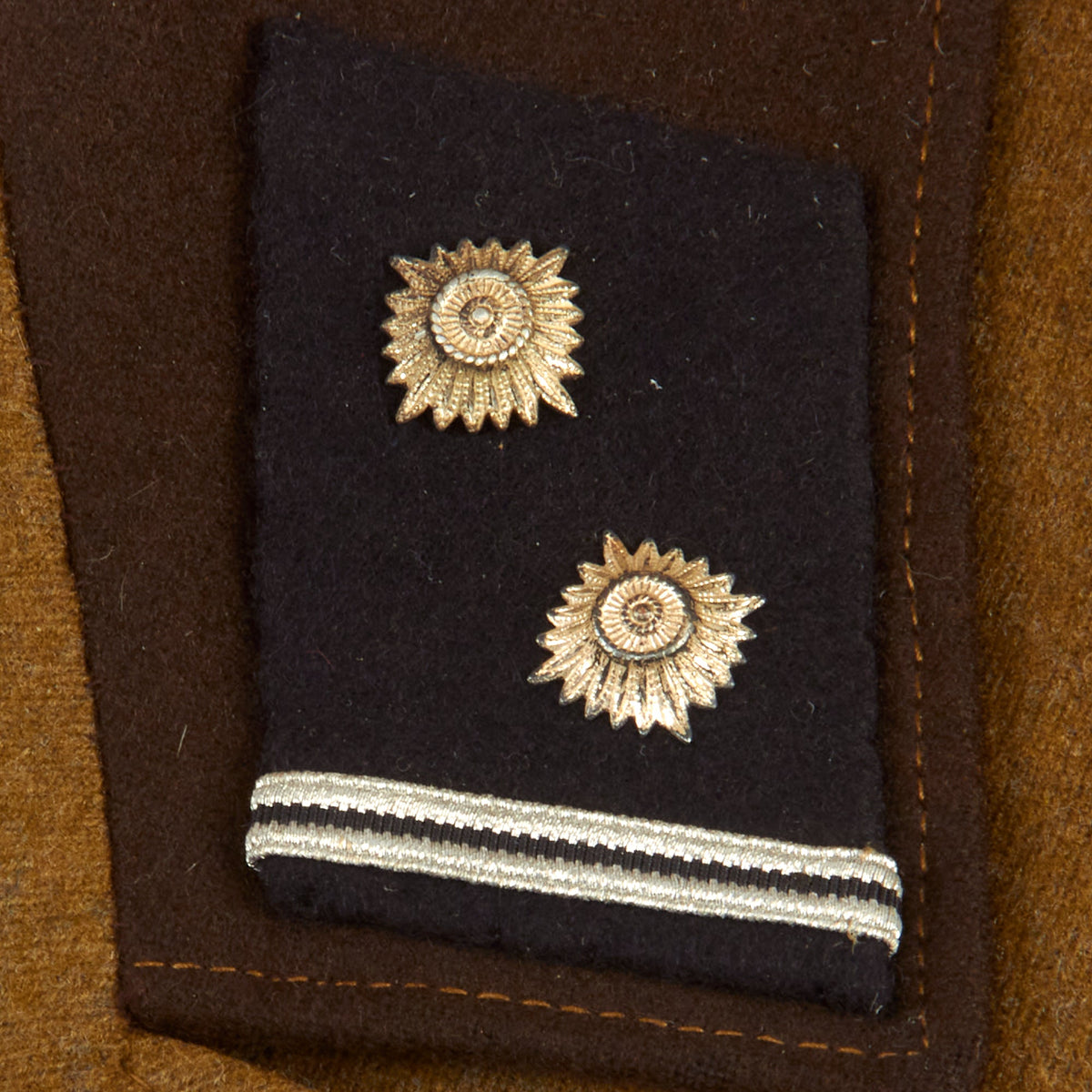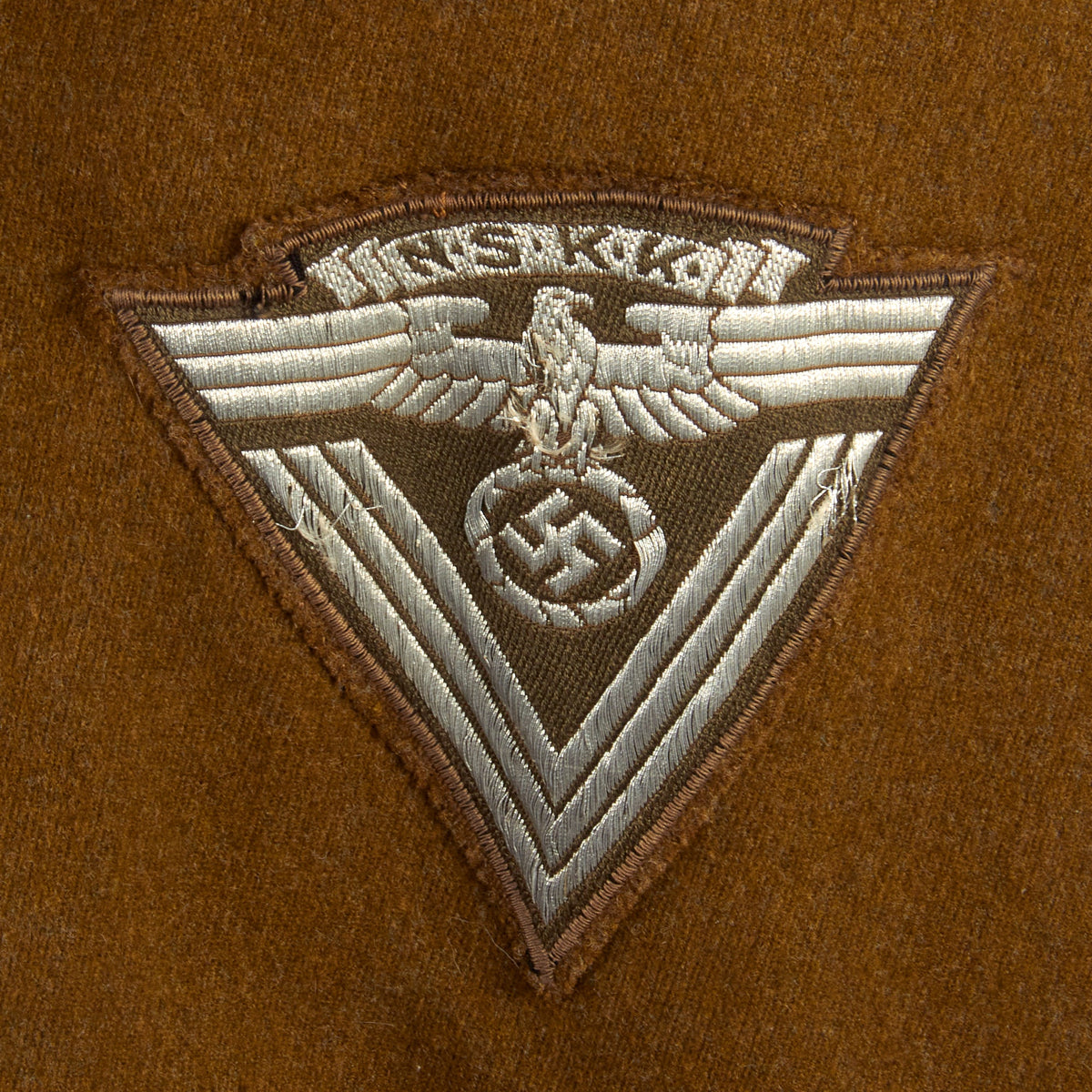Original Excellent German WWII NSKK Obertruppführer NCO Service Tunic From Motorsturm 4 / Motorstandarte 49 Original Items
$ 1.495,00 $ 373,75
Original Item: Only One Available. The National Socialist Motor Corps (NSKK) was a paramilitary organization of the NSDAP that officially existed from May 1931 to 1945. The group was a successor organisation to the older National Socialist Automobile Corps (NSAK), which had existed since April 1930.
The NSKK served as a training organization, mainly instructing members in the operation and maintenance of high-performance motorcycles and automobiles. The NSKK was further used to transport NSDAP and SA officials/members. The NSKK also served as a roadside assistance group in the mid-1930s, comparable to the modern-day American Automobile Association or the British Automobile Association. The outbreak of World War II in Europe caused the NSKK ranks to be recruited to serve in the transport corps of various German military branches. There was also a French section of the NSKK, which was organised after the German occupation of France began in 1940. The NSKK was the smallest of the NSDAP Party organizations.
Originally part of the SA, members of the NSKK originally wore the same “Brown Shirt” tunics and uniforms of that organization. After becoming an independent organization, they began wearing the NSKK.-Dienstrock (service tunic), which were much more similar to the standard military uniform.
This excellent condition NSKK Service Tunic belonged to an Obertruppführer (Senior Troop Leader) with Motorsturm 4 of the Motorstandarte 49. It is made from olive wool, with a dark brown collar and French cuffs on the end of the sleeves. It features a 4 button front closure and four pockets on the front with scalloped flaps. All of the pebbled buttons are magnetic with aluminized paint on the front, and are maker marked on the back. They are sewn directly to the fabric of the uniform. The interior of the tunic is lined with olive green rayon around the body, and striped rayon inside the sleeves.
The inner left breast pocket still bears its original fabric RZM tag, which is also in great shape. The tag identifies the tunic as an NSKK.-DIENSTROCK W, and features the ((RZM)) logo as well as the ink stamped numerical designation of the Hersteller (manufacturer) D/2 60189 over lot No. 027368.
The right shoulder of the tunic features a stitched in black and silver “checkered” NCO schulterklappe (shoulder strap), which is in great shape and features Navy Blue piping around the exterior. The NSKK retained the district colors from the SA, and Navy Blue could be either the Hansa Group (Hamburg, Mecklenburg, southern part of Schleswig-Holstein), or Hessen Group (Hesse-Nassau and parts of Hesse).
The kragenpatten (collar tabs) remain fully stitched on with all devices still properly attached, and are the correct black color with silver insignia. After separating from the SA the NSKK did away with the district colors on the collar insignia. The right collar tab is the unit tab, and 4 / 49 indicates the 4th Motorsturm (company), 49th Motorstandarte (Regiment). The left collar tab has two rank “pips” over a single silver/black/silver piping stripe, for the Senior NCO rank of NSKK-Obertruppführer (Senior Troop Leader), a troop leader equivalent to a German Army Stabsfeldwebel (Sgt. Major).
The tunic has the correct insignia for a long term member of the NSKK, including a high end wool and rayon multi-piece NSDAP / SA armelbinde (armband) on the left sleeve. Lower down on the sleeve is a 2nd Pattern aluminum bullion machine embroidered NSKK drivers diamond insignia. The right sleeve features an aluminum bullion embroidered NSKK Armwinkel für alte Kämpfer (Chevrons for old fighters), which features the NSKK eagle over triple chevrons. Only members who had been in NSDAP organizations such as the NSAK or SA prior to 1933 were permitted to wear this insignia
Overall condition is truly excellent, with no mothing, tearing, or other damage. It shows very little sign of use, and the only issue we can see is that there is a bit of pulling on the right sleeve chevron.
Comes more than ready to display!
Measurements:
Collar to shoulder: 9″
Shoulder to sleeve: 26”
Shoulder to shoulder: 15.5”
Chest width: 18″
Waist width: 18.5″
Hip width: 22″
Front length: 33″
History of the NSKK
The National Socialist Motor Corps (NSKK) was a successor organization to the older National Socialist Automobile Corps (NSAK), which had existed since being formed on 1 April 1930. Legends about the actual emergence of the NSKK go back as far as 1922, when the publisher of the Völkischer Beobachter (People’s Observer) and founding member of the German Workers’ Party (DAP), Dietrich Eckart, allegedly purchased trucks so the SA could perform their missions and transport propaganda materials. Martin Bormann founded the NSAK, which itself was the successor to the SA Motor Squadrons (Kraftfahrstaffeln). AH made the NSAK an official NSDAP organization on 1 April 1930. The NSAK was responsible for coordinating the use of donated motor vehicles belonging to party members, and later expanded to training members in automotive skills. Adolf Hühnlein was appointed Korpsführer (Corps Leader) of the NSAK, which was to serve primarily as a motorized corps of the Sturmabteilung (SA). Hühnlein became the organization’s “nucleus”.
The organization’s name was changed to the National Socialist Motor Corps (Nationalsozialistisches Kraftfahrkorps; NSKK), becoming official on 1 May 1931. It was essentially a paramilitary organization with its own system of paramilitary ranks and the smallest of the NSDAP organizations. Despite its relatively smaller size, when the NSDAP celebrated Braunschweiger SA-day on 18 October 1931, the NSKK had upwards of 5,000 vehicles at its disposal to move men and materials.
The primary aim of the NSKK was to educate its members in motoring skills or what was called “fitness in motoring skills” (Motorische Ertüchtigung), but it also transported NSDAP and SA officials. In the mid-1930s, the NSKK also served as a roadside assistance group, comparable to the modern-day American Automobile Association or the British Automobile Association.
Membership in the NSKK did not require any prior knowledge of automobiles. It was thought that training in the NSKK would make up for any previous lack of knowledge. Under the guidance of the police, numerous NSKK men were stationed at traffic junctions and trained in traffic control.
On 20 July 1934, weeks after the major purge of the SA in what became known as the Night of the Long Knives, the NSKK was separated and promoted into an independent NSDAP organization. From 1935 onward, the NSKK also provided training for Panzer crews and drivers of the Heer (German Army). The NSKK had two sub-branches within the organization known as the Motor-HJ (Motor-HJ Motor-HJ) and Naval NSKK (Marine-NSKK). The Motor-HJ branch was formed by Reichsjugendführer (HJ Leader) Baldur von Schirach after he became a member of the NSKK. It operated 350 of its own vehicles for educational and training purposes. The Naval NSKK trained men in the operation and maintenance of boats.
During the 1936 Olympics in Berlin, the NSKK assumed responsibility for a variety of transport tasks, proving themselves effective at political propaganda by transporting foreign visitors around on designated tours. By 1938, NSKK members were undergoing mechanical and operational training for both civilian and military type vehicles. Over time, the training at NSKK schools became primarily focused on military related tasks. For services to the NSKK and due in part to the general success of the NSKK, Hühnlein was promoted to the position of a Reichsleiter of the NSDAP in 1938. Hühnlein was NSKK Korpsführer from 1931 until he died in 1942, when Erwin Kraus took over.
Fast Shipping with Professional Packaging
Thanks to our longstanding association with UPS FedEx DHL, and other major international carriers, we are able to provide a range of shipping options. Our warehouse staff is expertly trained and will wrap your products according to our exact and precise specifications. Prior to shipping, your goods will be thoroughly examined and securely secured. We ship to thousands clients each day across multiple countries. This shows how we're dedicated to be the largest retailer on the internet. Warehouses and distribution centres can be located throughout Europe as well as the USA.
Note: Orders with more than one item will be assigned a processing date depending on the item.
Before shipping before shipping, we'll conduct a thorough inspection of the items you have ordered. Today, the majority of orders will be delivered within 48 hours. The delivery time will be between 3-7 days.
Returns
The stock is dynamic and we cannot completely manage it because multiple stakeholders are involved, including our factory and warehouse. So the actual stock may alter at any time. It's possible that you may not receive your order once the order has been made.
Our policy is valid for a period of 30 days. If you don't receive the product within 30 days, we are not able to issue a refund or an exchange.
You can only return an item if it is unused and in the same state as the day you received it. You must have the item in its original packaging.
Related products
Uncategorized
Uncategorized
Angolan Rebel 1970s era 60mm Inert Display Mortar from Angolan Civil War Original Items
Uncategorized
Uncategorized
Uncategorized
Uncategorized
Uncategorized
Uncategorized
Uncategorized
Uncategorized
Armoured Fighting Vehicles of the World: AFVs of World War One (Hardcover Book) New Made Items
Uncategorized
Uncategorized
Uncategorized
Uncategorized
Australian WWII Owen MK1 Machine Carbine SMG Custom Fabricated Replica with Sling Original Items












































































